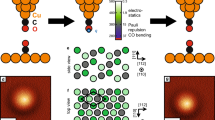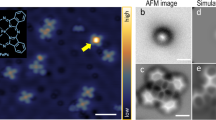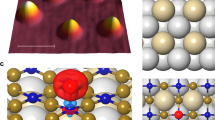Abstract
Heat transfer, electrical potential and light energy are common ways to activate chemical reactions. Applied force is another way, but dedicated studies for such a mechanical activation are limited, and this activation is poorly understood at the single-molecule level. Here, we report force-induced tautomerization in a single porphycene molecule on a Cu(110) surface at 5 K, which is studied by scanning probe microscopy and density functional theory calculations. Force spectroscopy quantifies the force needed to trigger tautomerization with submolecular spatial resolution. The calculations show how the reaction pathway and barrier of tautomerization are modified in the presence of a copper tip and reveal the atomistic origin of the process. Moreover, we demonstrate that a chemically inert tip whose apex is terminated by a xenon atom cannot induce the reaction because of a weak interaction with porphycene and a strong relaxation of xenon on the tip as contact to the molecule is formed.
This is a preview of subscription content, access via your institution
Access options
Subscribe to this journal
Receive 12 print issues and online access
$259.00 per year
only $21.58 per issue
Buy this article
- Purchase on Springer Link
- Instant access to full article PDF
Prices may be subject to local taxes which are calculated during checkout




Similar content being viewed by others
References
Beyer, M. K. & Clausen-Schaumann, H. Mechanochemistry: the mechanical activation of covalent bonds. Chem. Rev. 105, 2921–2948 (2005).
Gillespie, P. G. & Walker, R. G. Molecular basis of mechanosensory transduction. Nature 413, 194–202 (2001).
Davis, D. A. et al. Force-induced activation of covalent bonds in mechanoresponsive polymeric materials. Nature 459, 68–72 (2009).
Astumian, R. D. & Bier, M. Mechanochemical coupling of the motion of molecular motors to ATP hydrolysis. Biophys. J. 70, 637–653 (1996).
Bustamante, C., Chemla, Y. R., Forde, N. R. & Izhaky, D. Mechanical processes in biochemistry. Annu. Rev. Biochem. 73, 705–748 (2004).
Puchner, E. M. & Gaub, H. E. Single-molecule mechanoenzymatics. Annu. Rev. Biophys. 41, 497–518 (2012).
Nguyen, T. Q. & Kausch, H. H. Effects of solvent viscosity on polystyrene degradation in transient elongational flow. Macromolecules 23, 5137–5145 (1990).
Sohma, J. Mechanochemistry of polymers. Prog. Polym. Sci. 14, 451–596 (1989).
Nguyen, K. L., Friščič, T., Day, G. M., Gladden, L. F. & Jones, W. Terahertz time-domain spectroscopy and the quantitative monitoring of mechanochemical cocrystal formation. Nature Mater. 6, 206–209 (2007).
Halasz, I. et al. Real-time in situ powder X-ray diffraction monitoring of mechanochemical synthesis of pharmaceutical cocrystals. Angew. Chem. Int. Ed. 52, 11538–11541 (2013).
Loppacher, Ch. et al. Direct determination of the energy required to operate a single molecule switch. Phys. Rev. Lett. 90, 066107 (2003).
Ternes, M., Lutz, C. P., Hirjibehedin, C. F., Giessibl, F. J. & Heinrich, A. J. The force needed to move an atom on a surface. Science 319, 1066–1069 (2008).
Sweetman, A. et al. Toggling bistable atoms via mechanical switching of bond angle. Phys. Rev. Lett. 106, 136101 (2011).
Langewisch, G., Falter, J., Fuchs, H. & Schirmeisen, A. Forces during the controlled displacement of organic molecules. Phys. Rev. Lett. 110, 036101 (2013).
Yamazaki, S. et al. Interplay between switching driven by the tunneling current and atomic force of a bistable four-atom Si quantum dot. Nano Lett. 15, 4356–4363 (2015).
Kawai, S. et al. Quantifying the atomic-level mechanics of single long physisorbed molecular chains. Proc. Natl Acad. Sci. USA 111, 3968–3972 (2014).
Bombis, Ch. et al. Mechanical behavior of nanocrystalline NaCl islands on Cu(111). Phys. Rev. Lett. 104, 185502 (2010).
Ohshima, A., Momotake, A. & Arai, T. Photochromism, thermochromism, and solvatochromism of naphthalene-based analogues of salicylideneaniline in solution. J. Photochem. Photobiol. A 162, 473–479 (2004).
Tapia, O., Andres, J. & Safont, V. S. Theoretical study of transition structures for intramolecular hydrogen transfer in molecular models representing D-ribulose 1,5-bisphosphate. A possible molecular mechanism for the enolization step in Rubisco. J. Phys. Chem. 98, 4821–4830 (1994).
Heath, J. R. & Ratner, M. A. Molecular electronics. Phys. Today 56, 43–49 (May 2003).
Liljeroth, P., Repp, J. & Meyer, G. Current-induced hydrogen tautomerization and conductance switching of naphthalocyanine molecules. Science 317, 1203–1206 (2007).
Auwärter, W. et al. A surface-anchored molecular four-level conductance switch based on single proton transfer. Nature Nanotech. 7, 41–46 (2012).
Kumagai, T. et al. Thermally and vibrationally induced tautomerization of single porphycene molecules on a Cu(110) surface. Phys. Rev. Lett. 111, 246101 (2013).
Kumagai, T. et al. Controlling intramolecular hydrogen transfer in a porphycene molecule with single atoms or molecules located nearby. Nature Chem. 6, 41–46 (2014).
Ladenthin, J. N. et al. Hot carrier-induced tautomerization within a single porphycene molecule on Cu(111). ACS Nano 9, 7287–7295 (2015).
Kumagai, T. Direct observation and control of hydrogen-bond dynamics using low-temperature scanning tunneling microscopy. Prog. Surf. Sci. 90, 239–291 (2015).
Vogel, E., Köcher, M., Schmickler, H. & Lex, J. Porphycene—a novel porphin isomer. Angew. Chem. Int. Ed. Engl. 25, 257–259 (1986).
Gawinkowski, S. et al. Vibrations and hydrogen bonding in porphycene. Phys. Chem. Chem. Phys. 14, 5489–5503 (2012).
Fita, P., Urbańska, N., Radzewicz, C. & Waluk, J. Ground- and excited-state tautomerization rates in porphycenes. Chem. Eur. J. 15, 4851–4856 (2009).
Giessibl, F. J. Atomic resolution on Si(111)-(7×7) by noncontact atomic force microscopy with a force sensor based on a quartz tuning fork. Appl. Phys. Lett. 76, 1470–1472 (2000).
Lantz, M. A. et al. Quantitative measurement of short-range chemical bonding forces. Science 291, 2580–2583 (2001).
Ternes, M. et al. Interplay of conductance, force, and structural change in metallic point contacts. Phys. Rev. Lett. 106, 016802 (2011).
Sader, J. E. & Jarvis, S. P. Accurate formulas for interaction force and energy in frequency modulation force spectroscopy. Appl. Phys. Lett. 84, 1801–1803 (2004).
Mohn, F., Gross, L. & Meyer, G. Measuring the short-range force field above a single molecule with atomic resolution. Appl. Phys. Lett. 99, 053106 (2011).
Sugimoto, Y. et al. Role of tip chemical reactivity on atom manipulation process in dynamic force microscopy. ACS Nano 7, 7370–7376 (2013).
Eigler, D. M., Lutz, C. P. & Rudge, W. E. An atomic switch realized with the scanning tunnelling microscope. Nature 352, 600–603 (1991).
Falter, J. et al. Calibration of quartz tuning fork spring constants for non-contact atomic force microscopy direct mechanical measurements and simulations. Beilstein J. Nanotechnol. 5, 507–516 (2014).
Kozlowski, P. M., Zgierski, M. Z. & Baker, J. The inner-hydrogen migration and ground-state structure of porphycene. J. Chem. Phys. 109, 5905–5913 (1998).
Ciąćka, P. et al. Tautomerism in porphycenes: analysis of rate-affecting factors. J. Phys. Chem. B 119, 2292–2301 (2015).
Kumagai, T. et al. Direct observation of hydrogen-bond exchange within a single water dimer. Phys. Rev. Lett. 100, 166101 (2008).
Meng, X. et al. Direct visualization of concerted proton tunnelling in a water nanocluster. Nature Phys. 11, 235–239 (2015).
Gross, L., Mohn, F., Moll, N., Liljeroth, P. & Meyer, G. The chemical structure of a molecule resolved by atomic force microscopy. Science 325, 1110–1114 (2009).
Mohn, F., Schuler, B., Gross, L. & Meyer, G. Different tips for high-resolution atomic force microscopy and scanning tunneling microscopy of single molecules. Appl. Phys. Lett. 102, 073109 (2013).
Majzik, Z. et al. Simultaneous current, force and dissipation measurements on the Si(111) 7 × 7 surface with an optimized qPlus AFM/STM technique. Beilstein J. Nanotechnol. 3, 249–259 (2012).
Dion, M., Rydberg, H., Schröder, E., Langreth, D. C. & Lundqvist, B. I. Van der Waals density functional for general geometries. Phys. Rev. Lett. 92, 246401 (2004).
Román-Pérez, G. & Soler, J. M. Efficient implementation of a van der Waals density functional: application to double-wall carbon nanotubes. Phys. Rev. Lett. 103, 096102 (2009).
Klimeš, J., Bowler, D. R. & Michaelides, A. Chemical accuracy for the van der Waals density functional. J. Phys. Condens. Matter 22, 022201 (2010).
Mills, G., Jónsson, H. & Schenter, G. K. Reversible work transition state theory: application to dissociative adsorption of hydrogen. Surf. Sci. 324, 305–337 (1995).
Henkelman, G., Uberuaga, B. P. & Jónsson, H. A climbing image nudged elastic band method for finding saddle points and minimum energy paths. J. Chem. Phys. 113, 9901–9904 (2000).
Acknowledgements
J.N.L. and T.K. thank L. Grill, M. Wolf, A. Sweetman, O. Custance and A. Tkatchenko for discussions. T.K. acknowledges the support of the Morino Foundation for Molecular Science. T.F. acknowledges the support of the Basque Deptamento de Educación and the UPV/EHU (IT-756-13), the Spanish Ministerio de Economía y Competitividad (MAT2013-46593-C6-2-P) and the EU Integrated Project PAMS (610446). M.P. acknowledges computer time allocated on ARCHER through the Materials Chemistry Consortium funded by EPSRC grant no. EP/L000202, on Polaris through N8 HPC funded by EPSRC grant no. EP/K000225/1 and on Chadwick at the University of Liverpool. S.G. and J.W. acknowledge support from the Polish National Science Centre (grant no. DEC-2011/02/A/ST5/00043).
Author information
Authors and Affiliations
Contributions
T.K. conceived the experiments. J.N.L. and T.K. performed the measurements and analysed data. T.F., M.P. and J.C.S. performed all the DFT calculations. S.G. and J.W. provided porphycene molecules. T.K. wrote the manuscript. All authors discussed the results and commented on the manuscript.
Corresponding author
Ethics declarations
Competing interests
The authors declare no competing financial interests.
Supplementary information
Supplementary information
Supplementary information (PDF 2677 kb)
Rights and permissions
About this article
Cite this article
Ladenthin, J., Frederiksen, T., Persson, M. et al. Force-induced tautomerization in a single molecule. Nature Chem 8, 935–940 (2016). https://doi.org/10.1038/nchem.2552
Received:
Accepted:
Published:
Issue Date:
DOI: https://doi.org/10.1038/nchem.2552
This article is cited by
-
Voltage-driven control of single-molecule keto-enol equilibrium in a two-terminal junction system
Nature Communications (2023)
-
Chirality control of a single carbene molecule by tip-induced van der Waals interactions
Nature Communications (2023)
-
Mechanochemical Synthesis of PZT Powders and the Effects of Mechanical Activation on Solid-State Sintering Kinetics
Transactions of the Indian Institute of Metals (2023)
-
Probing CO on a rutile TiO2(110) surface using atomic force microscopy and Kelvin probe force microscopy
Nano Research (2022)
-
From molecular to supramolecular electronics
Nature Reviews Materials (2021)



